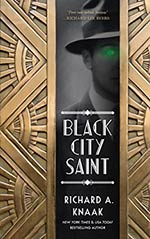
![]() Nymeria
Nymeria
11/17/2016
![]()
Urban Fantasy went a long way, lately, to disavow readers about the beauty and charm of the Fae world, and while Black City Saint is no exception, this book manages to bring the concept several steps further into darkness--and terror. If we had any residual delusion about these creatures, after reading this novel we will never look at queen Titania or king Oberon in the same way: at some point their Shakespearian counterparts are mentioned, but only to stress they are as far from the characters portrayed here as possible, and the Bard is shown as the fallible reporter of imperfect information.
The Gate separating Faerie from the mortal world used to be guarded by a powerful creature, a dragon, the very same that was slain by legendary Saint George who, in so doing, exposed the world of men to the dangers of contact with Faerie: the dragon slayer, now forever joined to the creature he vanquished--or what remains of it--is now both duty-bound and cursed to guard the portal between the two realms and as the story opens lives as occult investigator Nick Medea in the Chicago of the '20s, keeping watch for the creatures escaping though some crack in the Gate and hunting them without mercy.
There is a fascinating juxtaposition here between the fell denizens of Faerie and the Chicago underworld of gangsters and bootleggers, giving the story a peculiar noir feeling with a twist, a danger that remains unseen to most of the population but still affects their lives and the destiny of their city: the terrible fire that consumed most of it in the second half of the 19th century, for example, was in truth due to the dragon's fiery breath as Nick battled with Oberon, king of Faerie, and destroyed him--or so he thought.
As the story opens, Nick Medea perceives that something is terribly wrong, that darkness and danger are looming over his city, and the terrifying discovery is that Oberon survived and has been planning his return for long decades, intending to use Chicago as the battleground for his clash with queen Titania: here lies the true horror of the premise, that humanity is nothing more than collateral damage between two opposing forces of evil, one bent on conquest and the other driven to maintain her power, no matter the cost. Nick must act both as guardian and as balance between those powers, but he's dangerously distracted by the re-appearance of his love Cleolinda, the woman he already lost to death several times over the course of the centuries. When she contacts him to engage his professional skills, she appears as Claryce, a young woman worried about some strange events she witnessed, but Nick sees behind the façade and recognizes his many-times-lost love, deciding that this incarnation must survive, no matter what.
Despite the "damsel in distress" premise, Claryce is anything but: strong and determined she constantly refuses to be left behind or to stay safe, on the contrary she demands to be part of the action, especially when her feelings for Nick start surfacing. This is indeed a refreshing approach both for the genre and for the time period chosen as background: even when the truth about her nature and the past she doesn't remember are revealed, she wastes no time in needless lamentations, showing a remarkable backbone that makes her stand out in interesting light and ultimately reveals her for the bold fighter she is, a true warrior princess of old.
Curiously enough, the main character Nick Medea is less defined than his companions: apart from his history, that comes up in bits and pieces over the course of the book, little is revealed about him beyond his determination to fulfill his task and the terrible memories that haunt his days and his tormented nights. Moreover, events tend to depict him as somewhat easily deceived, since more than once he falls prey to others' machinations: true, heroes don't have necessarily to be perfect, but poor Nick Medea sometimes fails to connect the dots...
Much more interesting is Fetch, his lycanthrope side-kick, an exile from Faerie who can talk when in proximity with Nick and expresses himself in an entertaining mix of old-fashioned language and contemporary slang that manages to define his mercurial personality in sharp relief: I can say with certainty that he's the character that most appealed to me, the one that felt more real and three-dimensional, even in the surprising developments centered around him in the course of the story.
Equally interesting--in a disquieting sort of way--are Diocles (the ghost of former emperor Diocletianus, and Saint George's executioner) and Kravayik, another exile from Faerie: this creature, draping himself in human form that can barely disguise his otherwordly origins, is one of the most intriguing figures, a staunch observer of the commandments of the Church after his conversion to religion. His total devotion and subservience to Nick, coupled with hints about his true nature, make him one of the creepiest figures in this novel, as fascinating as a caged anaconda - a creature best observed from a safe distance.
The story is an absorbing and swift read, and only sags slightly in the central segment, where the narrative hits a sort of repetitive loop: it takes flight again shortly after, though, and reaches its apex in the last fifty-odd pages, where the action speeds up at a breakneck pace through sudden betrayals, about-faces and the climax of Oberon's decades-long plan for conquest, closing the book with a very satisfying ending that hints at possible sequels. Something I would be quite interested in...
http://spaceandsorcery.wordpress.com